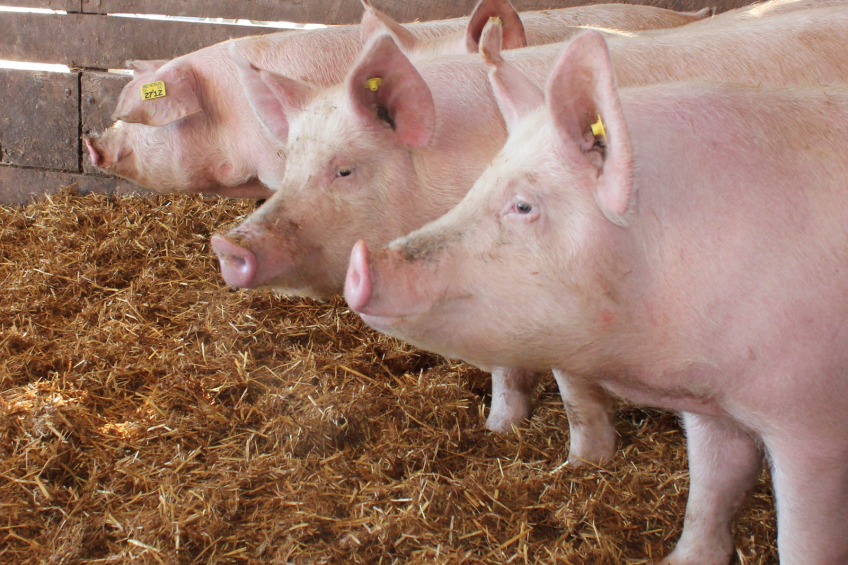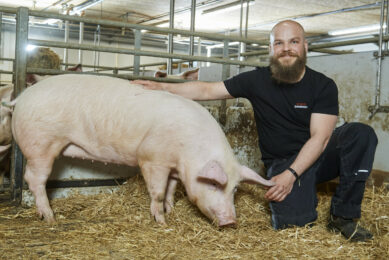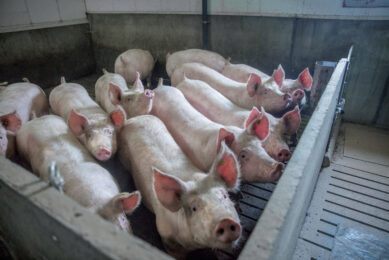Adjust sow nutrition to handle seasonal changes

Performance of sows and gilts depends on many factors. Their direct environment is not an exception to that, as temperature and humidity can play a major role by leading to fluctuations in body condition score.
By Dr Vern Pearson, swine nutritionist, Purina Animal Nutrition
Pigs adapt well to their environment, which is good for their survivability. But for sows, that adaptation can come at a cost in terms of long-term performance.
When sows use their physical coping mechanisms to regulate their core body temperature in conditions of cold or heat stress, they must allocate resources away from other body functions.
The results may be damaging to a sows’ body condition; fertility; milk production and/ or piglet survival and growth performance. The most common impact of temperature stress is often decreased feed intake in hot weather and not enough feed intake in cold weather to maintain the sow.
To keep intake levels at the necessary levels to achieve performance goals, changes in the ration should be made throughout the year to keep sows at a body condition score (BCS) of 3 on a 5-point scale. Maintaining this BCS through all stages can help the sows perform to their full potential through all seasons.
Cold stress burns energy
Shivering is a sow’s natural response to combatting cold stress by generating internal heat via muscle friction. The energy expended via this additional movement will use up feed energy that otherwise would be allocated to maintaining or restoring body condition. The sow maintains the gestation and lactation utilising her own body resources which may result in reducing her own condition.
Sows also eat more in colder conditions because digestion generates internal heat besides the additional energy needed for body and litter maintenance. Industry estimates suggest that sows could consume up to 25% more feed in extremely cold conditions.
In curtain-sided or environmentally controlled gestation and farrowing barns, cold stress usually is not a major challenge. Adult sows typically provide enough heat to warm the barn under most conditions. Care should be taken, however, to ensure that mechanical ventilation does not create excessive air movement that could cause a ‘wind chill’ effect inside climate-controlled barns.
Cold stress is a more prominent issue in open-fronted and open-sided barns used to house sows. In those settings, additional bedding and management of drafts can help minimise chilling of animals.
Nutritional adjustments also can be made to help sows cope with cold stress without interfering with other performance parameters. Providing fresh feed more frequently will help to address sows’ natural desire to eat more. Increasing the content of bulky, high-fibre ingredients such as oats, barley, beet pulp, wheat bran, DDGS, alfalfa meal and soybean hulls can help to increase the amount of heat produced by the sow for digestion; slow the ration passage rate; dilute the energy concentration of the ration; and often reduce overall ration costs.
Depending on the age, stage of gestation and body condition of sows, adding more fat to the ration to boost energy levels may also be beneficial during cold stress. First-litter gilts still are growing to their mature size and have greater nutritional needs than older sows. Late-gestation and lactating sows of all ages need more energy to support birth and weaning weights and milk production. And thin sows (lower than a score of 3 on a 5-point scale) need more energy to withstand cold conditions without sacrificing additional body condition.
Feed consumption
Sows during hot, humid summer months may begin to feel heat stress at lower temperatures than producers may think. In fact, research shows that sows begin to feel the effects of heat stress at approximately 21°C (70°F), depending on humidity levels. The range of 16 to 18°C (60 to 65°F) is the optimal ambient temperature for lactating sows. Elevated temperature and humidity both can bother sows, and stress levels can elevate as one or both factors rise. The Temperature Humidity Index (THI) is a factor that accounts for both temperature and humidity level. Figure 1 shows the impact of heat stress on sows.
As temperatures rise, sows will increase their respiration rate to expel body heat. Panting behaviour is an obvious sign of heat stress, and causes sows to expend additional energy. To monitor sows’ resting respiration rate, count the number of times the rib cage moves in and out in a 60-second period. Normal respiration rates are between 15 and 25 breaths per minute. When respiration rates exceed 40 breaths per minute, sows are experiencing heat stress.
Other signs of heat stress are: sows sprawling on the floor to increase their physical contact with the cooler floor surface; lower physical activity; seeking water to cool their skin; and reduced feed intake. Cold stress is just the opposite and the sows are huddled together in one area of the pen.
Air movement through sow housing unit is an important factor for heat stress abatement. Recommended air-movement rates for enclosed facilities are: sows with litters – 500 cubic feet per minute (CFMs); gestating sows – 180 CFMs; and breeding sows – 300 CFMs. This equals to 14,000, 5,000 and 8,500 litres per minute respectively.
Ensuring that fresh water is available to sows at all times will help to promote water consumption. An increase in air temperature from 12 to 16°C (54 to 60°F) to 30 to 35°C (86 to 95°F) can cause sows to drink more than 50% more water. A good rule of thumb is to maintain a feed-to-water ratio of 5:1. Provide water near 10°C (50°F) for optimal consumption. Sows during lactation can drink 30-40 litres (8-10.5 gallons) of water daily. This can double during severe hot weather.
Scheduling animal activities in the morning and evening will help to ensure sows are not overly stressed during the hottest parts of the day. In addition, sows do not have the ability to sweat to cool them, so evaporative cooling with sprinklers, drippers, misters and foggers can provide tremendous heat stress relief.
Because sows eat less in periods of heat stress, reducing crude protein or increasing fat levels to provide more available energy can help address the long-term effects of nutritional disruption. This can be accomplished by incorporating a summer feed additive into the ration.
Feeding a ration that is more nutrient-dense and lower in fibre will help to speed digestion and reduce energy requirements for digestion, thus producing less heat. Include higher levels of fat, such as tallow, choice white grease or vegetable oil at 2-6% of the diet, and avoid feeding fibrous ingredients at high levels.
Delivering rations in smaller, more frequent meals helps minimise heat generation in addition to promoting intake. Increasing feeding frequency also may reduce spoilage and encourage more frequent eating. Research has shown that switching from two large meals to three small meals can increase sow intake rates by 10-15%.
Monitor body condition carefully during hot weather. An ad libitum ration is recommended during lactation, with limit-feeding during gestation. First-litter gilts and thin sows may require additional energy in the ration, particularly to support fertility. But over-conditioning of sows also should be avoided, as over-conditioned sows struggle more with heat stress and may have more complications during farrowing.
Most regions are subject to weather extremes – either heat or cold or both. Thus, more than a one-size-fits-all approach for sow management and nutrition is necessary. Fine-tuning management practices and rations to help sows handle heat stress should pay off in more consistent performance potential and greater longevity in the sow herd.
Depending on ventilation, stocking rate, humidity and weight of the sow, temperatures as low as 21°C (70°F) can start to affect sow feed intake.
References available on request






